check engine TOYOTA YARIS CROSS 2022 Owners Manual
[x] Cancel search | Manufacturer: TOYOTA, Model Year: 2022, Model line: YARIS CROSS, Model: TOYOTA YARIS CROSS 2022Pages: 618, PDF Size: 130.77 MB
Page 6 of 618
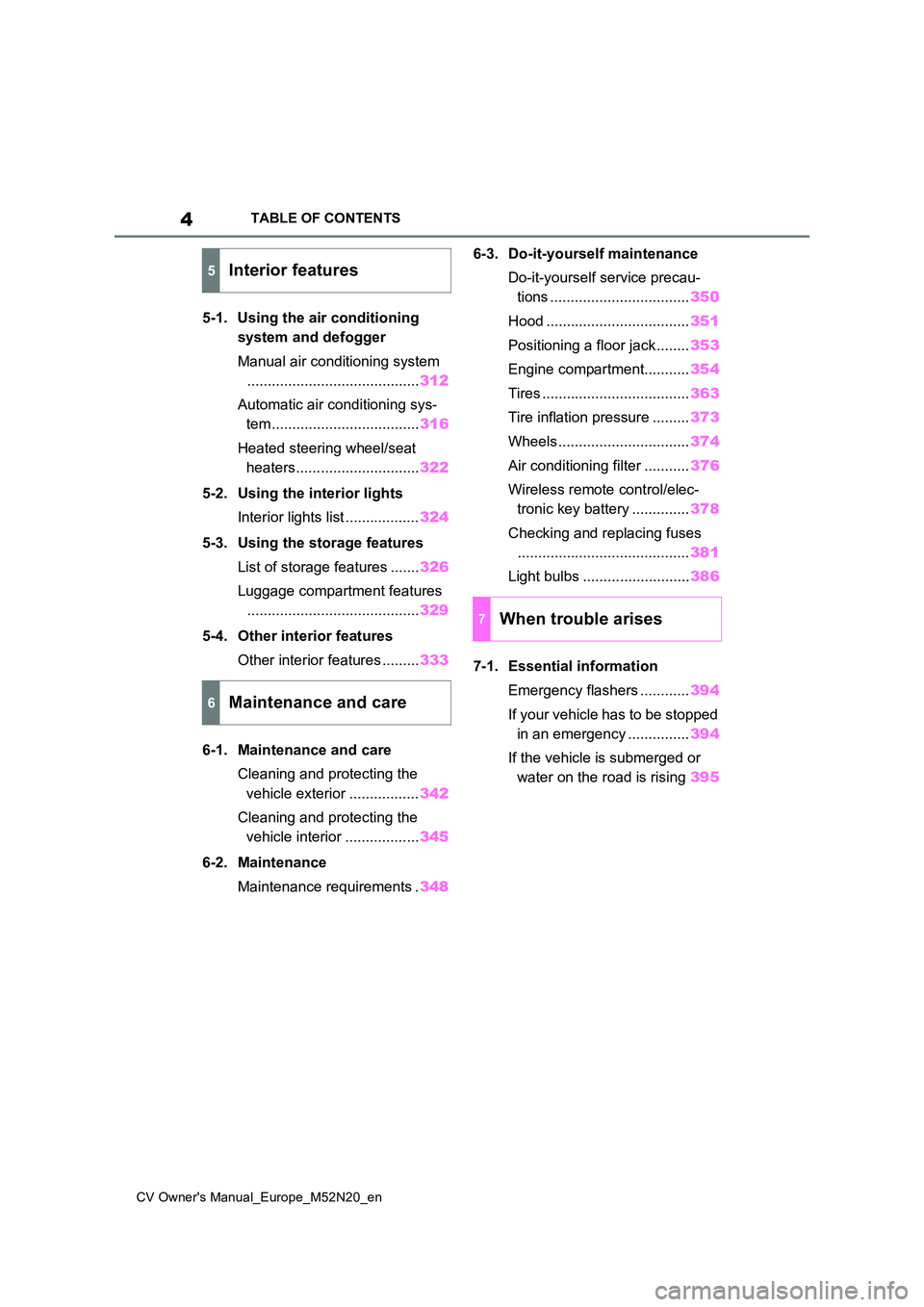
4
CV Owner's Manual_Europe_M52N20_en
TABLE OF CONTENTS
5-1. Using the air conditioning
system and defogger
Manual air conditioning system
.......................................... 312
Automatic air conditioning sys-
tem .................................... 316
Heated steering wheel/seat
heaters.............................. 322
5-2. Using the interior lights
Interior lights list .................. 324
5-3. Using the storage features
List of storage features ....... 326
Luggage compartment features
.......................................... 329
5-4. Other interior features
Other interior features ......... 333
6-1. Maintenance and care
Cleaning and protecting the
vehicle exterior ................. 342
Cleaning and protecting the
vehicle interior .................. 345
6-2. Maintenance
Maintenance requirements . 348
6-3. Do-it-yourself maintenance
Do-it-yourself service precau-
tions .................................. 350
Hood ................................... 351
Positioning a floor jack ........ 353
Engine compartment........... 354
Tires .................................... 363
Tire inflation pressure ......... 373
Wheels ................................ 374
Air conditioning filter ........... 376
Wireless remote control/elec-
tronic key battery .............. 378
Checking and replacing fuses
.......................................... 381
Light bulbs .......................... 386
7-1. Essential information
Emergency flashers ............ 394
If your vehicle has to be stopped
in an emergency ............... 394
If the vehicle is submerged or
water on the road is rising 395
5Interior features
6Maintenance and care
7When trouble arises
Page 15 of 618
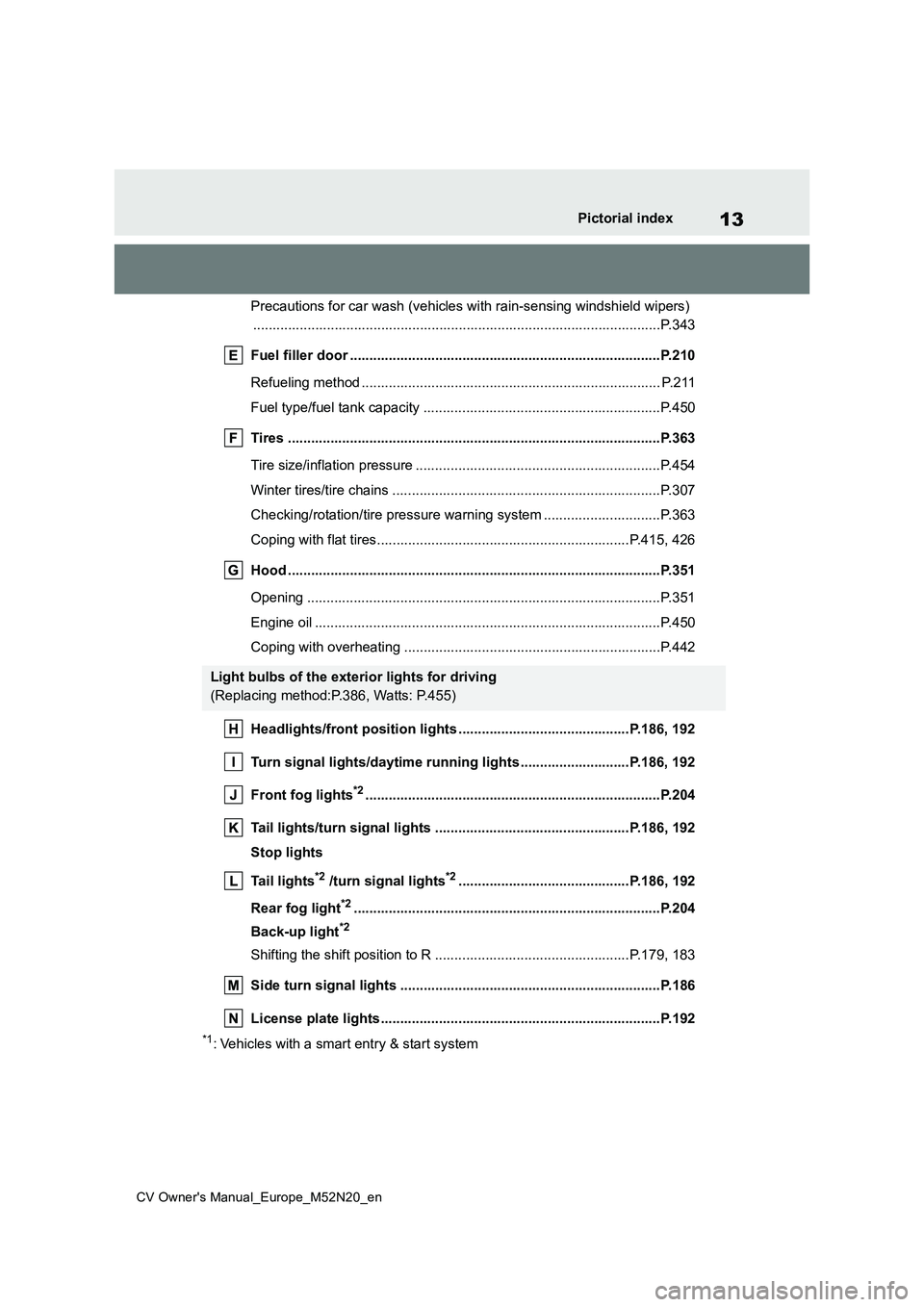
13
CV Owner's Manual_Europe_M52N20_en
Pictorial index
Precautions for car wash (vehicles with rain-sensing windshield wipers)
............................................................... ..........................................P.343
Fuel filler door ............................................... .................................P.210
Refueling method ............................................... .............................. P.211
Fuel type/fuel tank capacity ................................... ..........................P.450
Tires .......................................................... ......................................P.363
Tire size/inflation pressure ................................... ............................P.454
Winter tires/tire chains ....................................... ..............................P.307
Checking/rotation/tire pressure warning system ................. .............P.363
Coping with flat tires......................................... ........................P.415, 426
Hood ........................................................... .....................................P.351
Opening ........................................................ ...................................P.351
Engine oil ..................................................... ....................................P.450
Coping with overheating ........................................ ..........................P.442
Headlights/front position lights ............................... .............P.186, 192
Turn signal lights/daytime running lights ...................... ......P.186, 192
Front fog lights*2............................................................... .............P.204
Tail lights/turn signal lights ................................. .................P.186, 192
Stop lights
Tail lights*2 /turn signal lights*2............................................P.186, 192
Rear fog light*2............................................................... ................P.204
Back-up light*2
Shifting the shift position to R ............................... ...................P.179, 183
Side turn signal lights ........................................ ...........................P.186
License plate lights........................................... .............................P.192
*1: Vehicles with a smart entry & start system
Light bulbs of the exterior lights for driving
(Replacing method:P.386, Watts: P.455)
Page 48 of 618
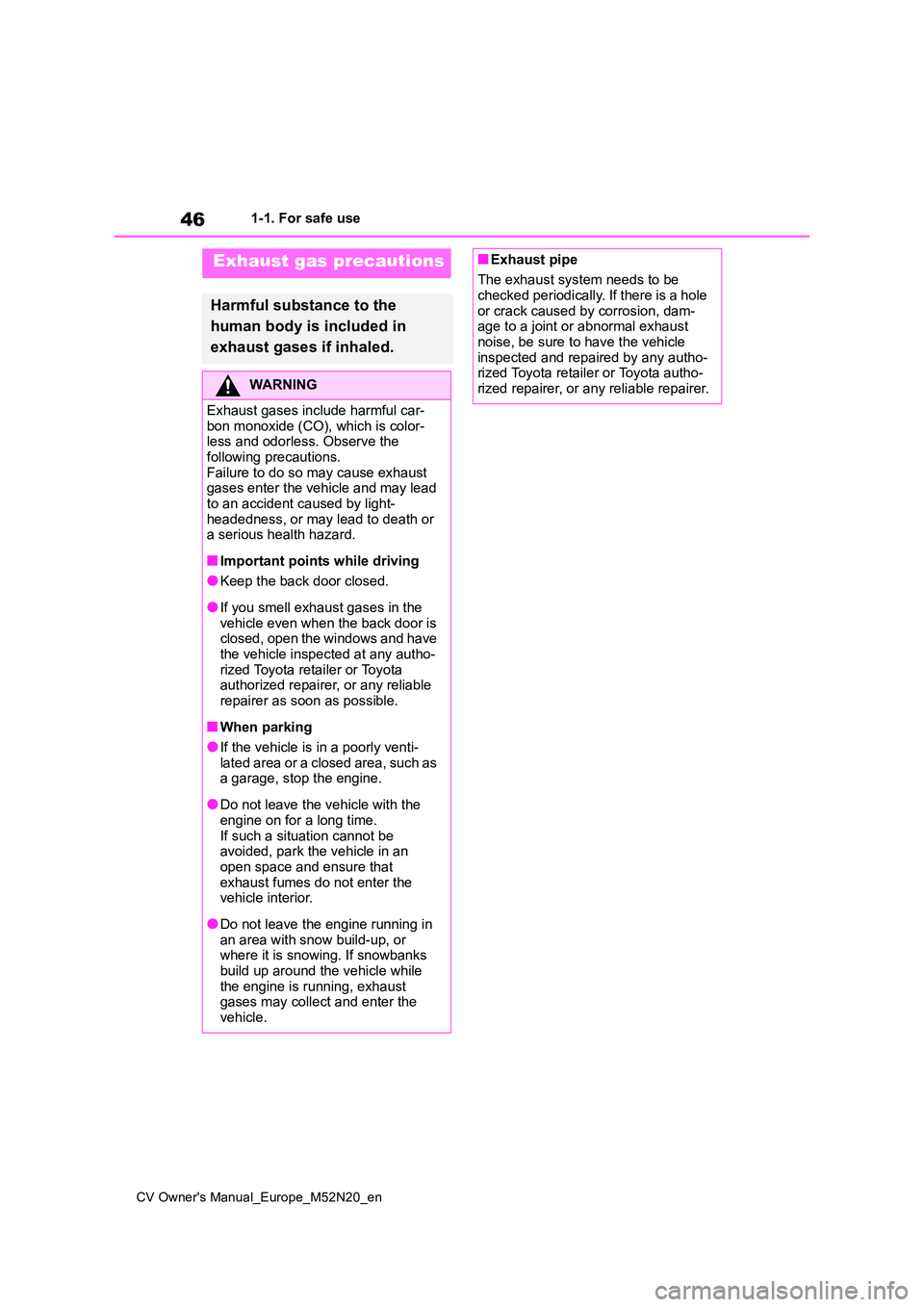
46
CV Owner's Manual_Europe_M52N20_en
1-1. For safe use
Exhaust gas precautions
Harmful substance to the
human body is included in
exhaust gases if inhaled.
WARNING
Exhaust gases include harmful car-
bon monoxide (CO), which is color- less and odorless. Observe the following precautions.
Failure to do so may cause exhaust gases enter the vehicle and may lead to an accident caused by light-
headedness, or may lead to death or a serious health hazard.
■Important points while driving
●Keep the back door closed.
●If you smell exhaust gases in the vehicle even when the back door is closed, open the windows and have
the vehicle inspected at any autho- rized Toyota retailer or Toyota authorized repairer, or any reliable
repairer as soon as possible.
■When parking
●If the vehicle is in a poorly venti- lated area or a closed area, such as a garage, stop the engine.
●Do not leave the vehicle with the engine on for a long time.
If such a situation cannot be avoided, park the vehicle in an open space and ensure that
exhaust fumes do not enter the vehicle interior.
●Do not leave the engine running in an area with snow build-up, or where it is snowing. If snowbanks
build up around the vehicle while the engine is running, exhaust gases may collect and enter the
vehicle.
■Exhaust pipe
The exhaust system needs to be checked periodically. If there is a hole
or crack caused by corrosion, dam- age to a joint or abnormal exhaust noise, be sure to have the vehicle
inspected and repaired by any autho- rized Toyota retailer or Toyota autho-rized repairer, or any reliable repairer.
Page 79 of 618
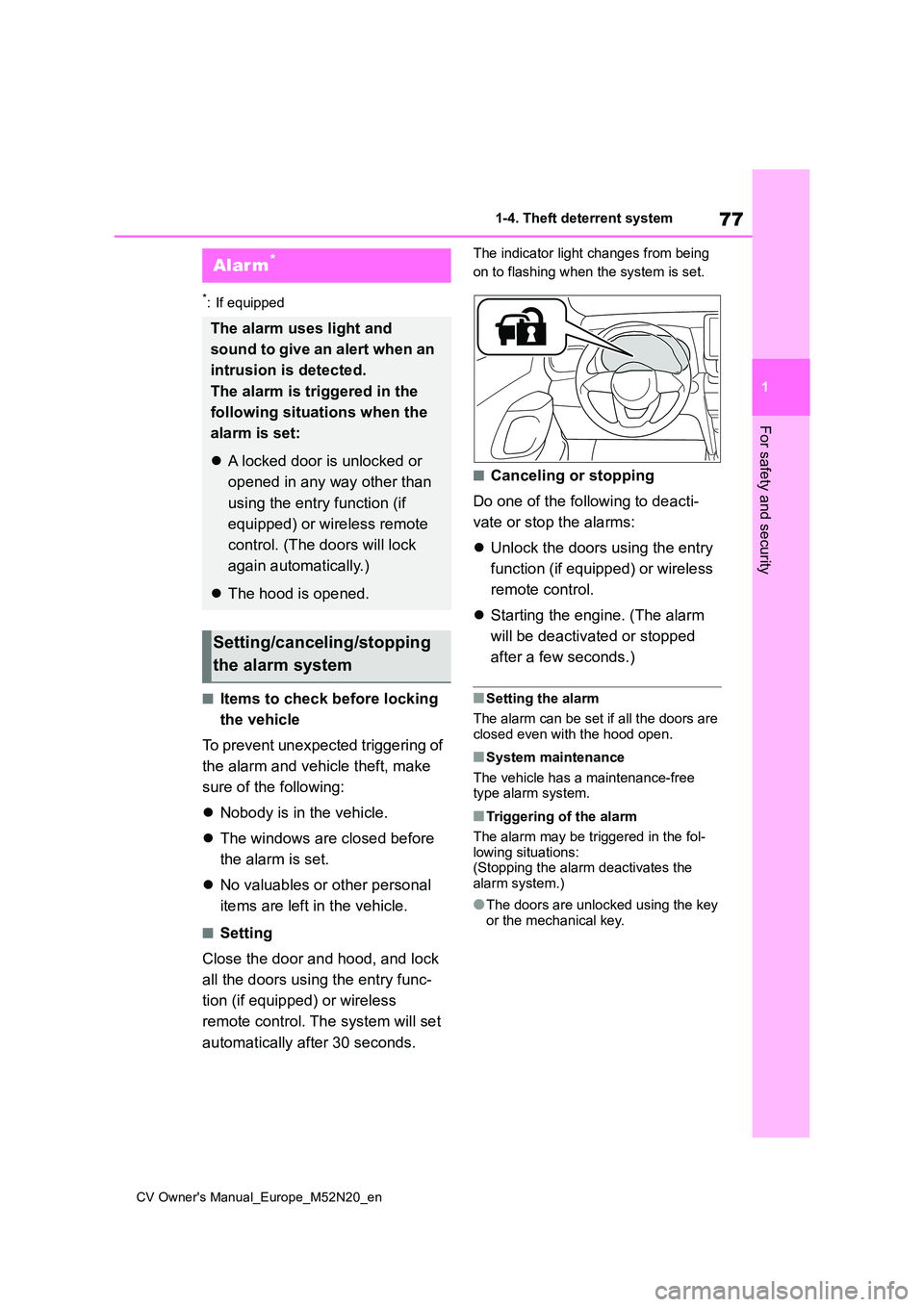
77
1
CV Owner's Manual_Europe_M52N20_en
1-4. Theft deterrent system
For safety and security
*: If equipped
■Items to check before locking
the vehicle
To prevent unexpected triggering of
the alarm and vehicle theft, make
sure of the following:
Nobody is in the vehicle.
The windows are closed before
the alarm is set.
No valuables or other personal
items are left in the vehicle.
■Setting
Close the door and hood, and lock
all the doors using the entry func-
tion (if equipped) or wireless
remote control. The system will set
automatically after 30 seconds.
The indicator light changes from being
on to flashing when the system is set.
■Canceling or stopping
Do one of the following to deacti-
vate or stop the alarms:
Unlock the doors using the entry
function (if equipped) or wireless
remote control.
Starting the engine. (The alarm
will be deactivated or stopped
after a few seconds.)
■Setting the alarm
The alarm can be set if all the doors are closed even with the hood open.
■System maintenance
The vehicle has a maintenance-free type alarm system.
■Triggering of the alarm
The alarm may be triggered in the fol-
lowing situations: (Stopping the alarm deactivates the alarm system.)
●The doors are unlocked using the key or the mechanical key.
Alarm*
The alarm uses light and
sound to give an alert when an
intrusion is detected.
The alarm is triggered in the
following situations when the
alarm is set:
A locked door is unlocked or
opened in any way other than
using the entry function (if
equipped) or wireless remote
control. (The doors will lock
again automatically.)
The hood is opened.
Setting/canceling/stopping
the alarm system
Page 84 of 618
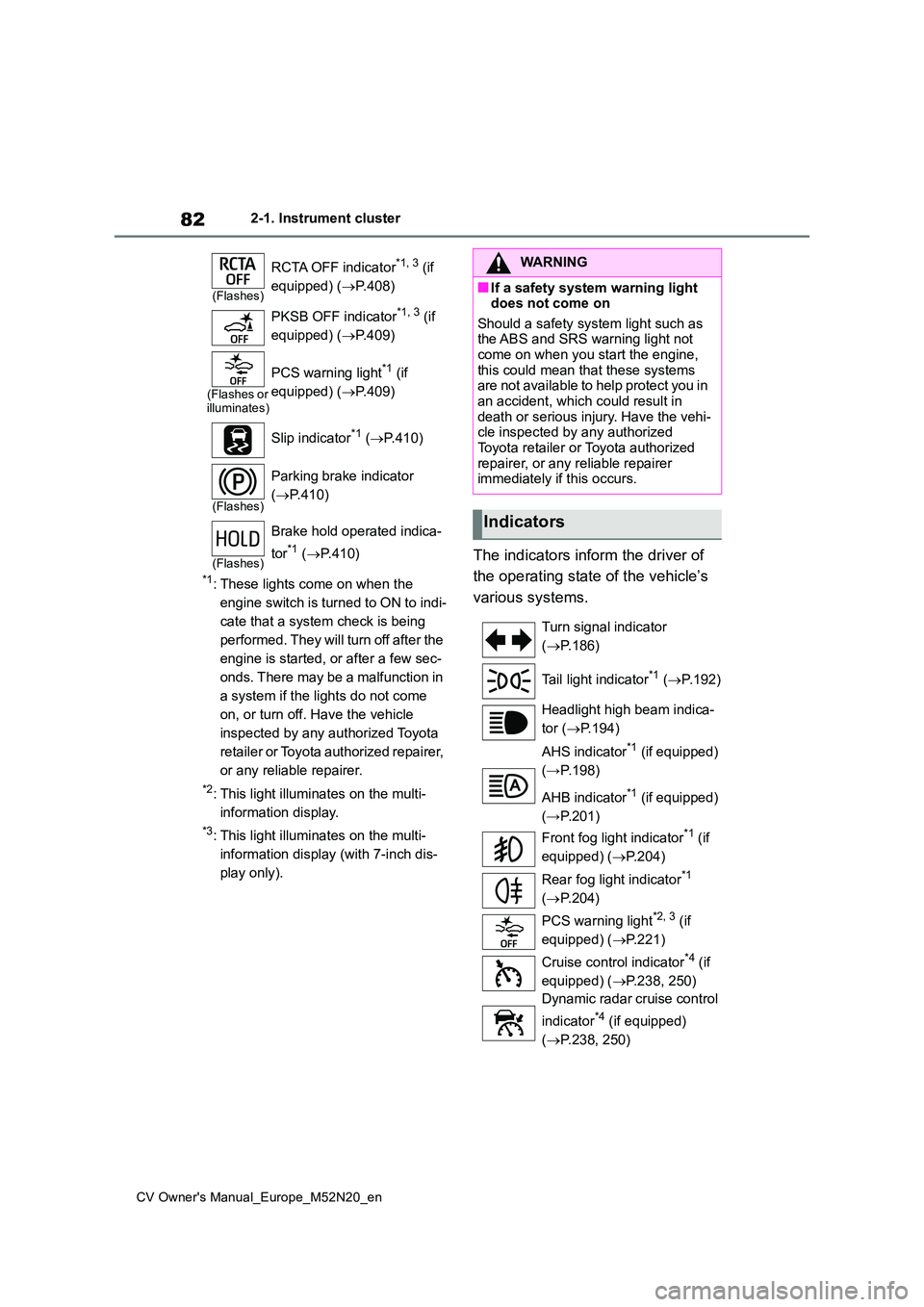
82
CV Owner's Manual_Europe_M52N20_en
2-1. Instrument cluster
*1: These lights come on when the
engine switch is turned to ON to indi-
cate that a system check is being
performed. They will turn off after the
engine is started, or after a few sec-
onds. There may be a malfunction in
a system if the lights do not come
on, or turn off. Have the vehicle
inspected by any authorized Toyota
retailer or Toyota authorized repairer,
or any reliable repairer.
*2: This light illuminates on the multi-
information display.
*3: This light illuminates on the multi-
information display (with 7-inch dis-
play only).
The indicators inform the driver of
the operating state of the vehicle’s
various systems.
(Flashes)
RCTA OFF indicator*1, 3 (if
equipped) ( P.408)
PKSB OFF indicator*1, 3 (if
equipped) ( P.409)
(Flashes or illuminates)
PCS warning light*1 (if
equipped) ( P.409)
Slip indicator*1 ( P.410)
(Flashes)
Parking brake indicator
( P.410)
(Flashes)
Brake hold operated indica-
tor*1 ( P.410)
WARNING
■If a safety system warning light does not come on
Should a safety system light such as the ABS and SRS warning light not come on when you start the engine,
this could mean that these systems are not available to help protect you in an accident, which could result in
death or serious injury. Have the vehi- cle inspected by any authorized Toyota retailer or Toyota authorized
repairer, or any reliable repairer immediately if this occurs.
Indicators
Turn signal indicator
( P.186)
Tail light indicator*1 ( P.192)
Headlight high beam indica-
tor ( P.194)
AHS indicator*1 (if equipped)
(→P.198)
AHB indicator*1 (if equipped)
(→P.201)
Front fog light indicator*1 (if
equipped) ( P.204)
Rear fog light indicator*1
( P.204)
PCS warning light*2, 3 (if
equipped) ( P.221)
Cruise control indicator*4 (if
equipped) ( P.238, 250)
Dynamic radar cruise control
indicator*4 (if equipped)
( P.238, 250)
Page 85 of 618
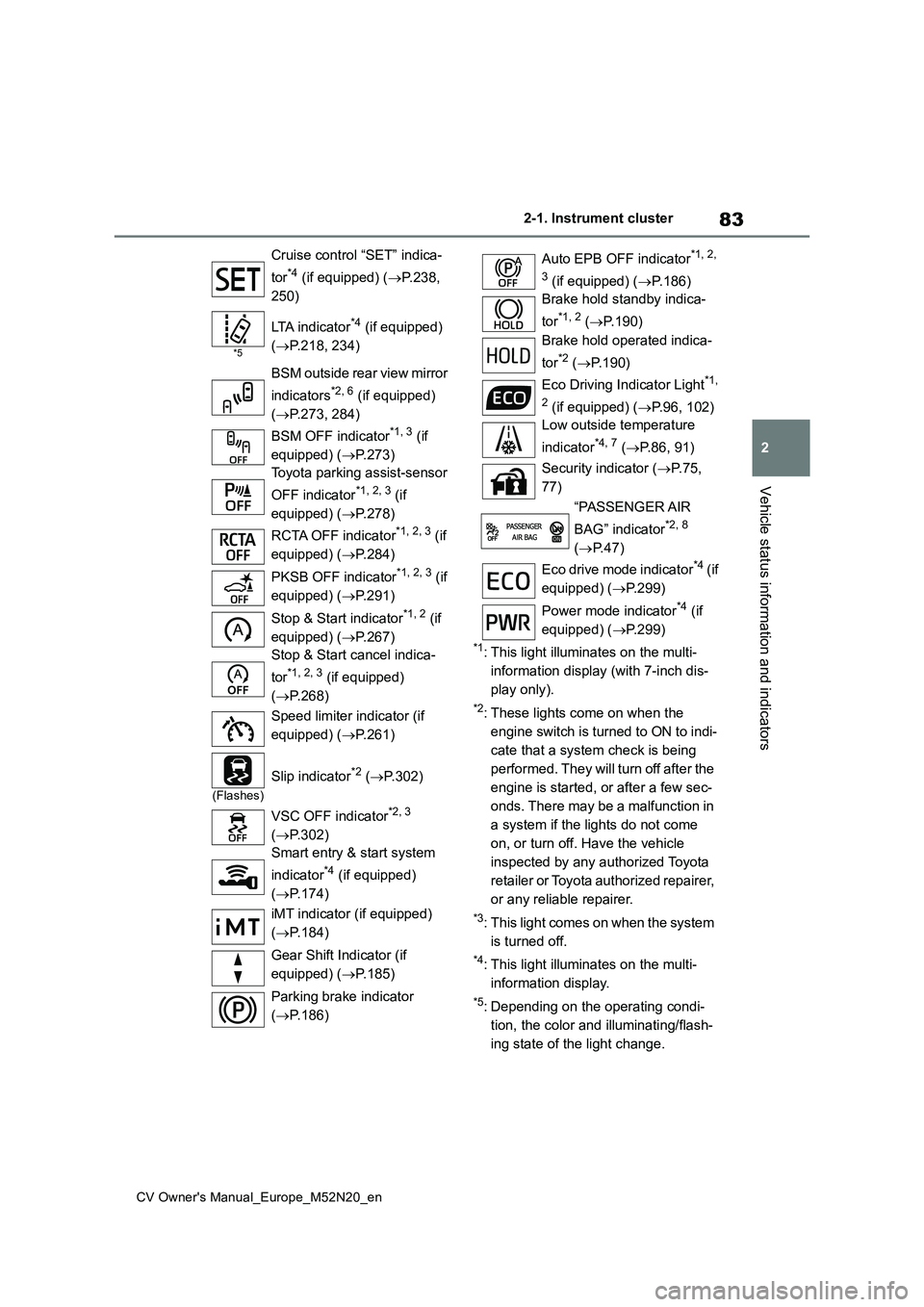
83
2
CV Owner's Manual_Europe_M52N20_en
2-1. Instrument cluster
Vehicle status information and indicators
*1: This light illuminates on the multi-
information display (with 7-inch dis-
play only).
*2: These lights come on when the
engine switch is turned to ON to indi-
cate that a system check is being
performed. They will turn off after the
engine is started, or after a few sec-
onds. There may be a malfunction in
a system if the lights do not come
on, or turn off. Have the vehicle
inspected by any authorized Toyota
retailer or Toyota authorized repairer,
or any reliable repairer.
*3: This light comes on when the system
is turned off.
*4: This light illuminates on the multi-
information display.
*5: Depending on the operating condi-
tion, the color and illuminating/flash-
ing state of the light change.
Cruise control “SET” indica-
tor*4 (if equipped) ( P.238,
250)
*5
LTA indicator*4 (if equipped)
( P.218, 234)
BSM outside rear view mirror
indicators*2, 6 (if equipped)
( P.273, 284)
BSM OFF indicator*1, 3 (if
equipped) ( P.273)
Toyota parking assist-sensor
OFF indicator*1, 2, 3 (if
equipped) ( P.278)
RCTA OFF indicator*1, 2, 3 (if
equipped) ( P.284)
PKSB OFF indicator*1, 2, 3 (if
equipped) ( P.291)
Stop & Start indicator*1, 2 (if
equipped) ( P.267)
Stop & Start cancel indica-
tor*1, 2, 3 (if equipped)
( P.268)
Speed limiter indicator (if
equipped) ( P.261)
(Flashes)
Slip indicator*2 (P.302)
VSC OFF indicator*2, 3
( P.302)
Smart entry & start system
indicator*4 (if equipped)
( P.174)
iMT indicator (if equipped)
( P.184)
Gear Shift Indicator (if
equipped) ( P.185)
Parking brake indicator
( P.186)
Auto EPB OFF indicator*1, 2,
3 (if equipped) ( P.186)
Brake hold standby indica-
tor*1, 2 ( P.190)
Brake hold operated indica-
tor*2 ( P.190)
Eco Driving Indicator Light*1,
2 (if equipped) ( P.96, 102)
Low outside temperature
indicator*4, 7 ( P.86, 91)
Security indicator ( P. 7 5 ,
77)
“PASSENGER AIR
BAG” indicator*2, 8
( P.47)
Eco drive mode indicator*4 ( i f
equipped) ( P.299)
Power mode indicator*4 (if
equipped) ( P.299)
Page 89 of 618
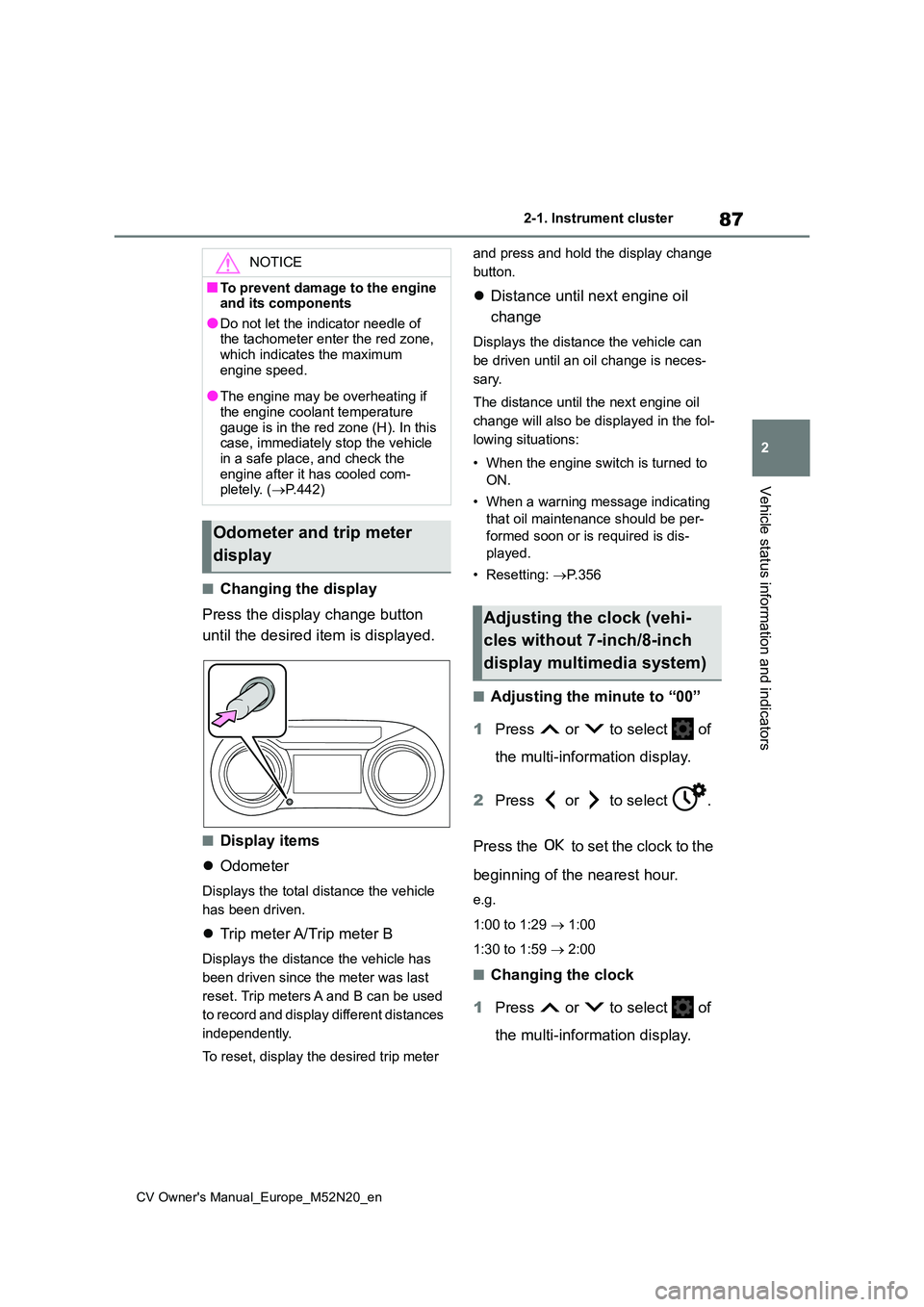
87
2
CV Owner's Manual_Europe_M52N20_en
2-1. Instrument cluster
Vehicle status information and indicators
■Changing the display
Press the display change button
until the desired item is displayed.
■Display items
Odometer
Displays the total distance the vehicle
has been driven.
Trip meter A/Trip meter B
Displays the distance the vehicle has
been driven since the meter was last
reset. Trip meters A and B can be used
to record and display different distances
independently.
To reset, display the desired trip meter
and press and hold the display change
button.
Distance until next engine oil
change
Displays the distance the vehicle can
be driven until an oil change is neces-
sary.
The distance until the next engine oil
change will also be displayed in the fol-
lowing situations:
• When the engine switch is turned to
ON.
• When a warning message indicating
that oil maintenance should be per-
formed soon or is required is dis-
played.
• Resetting: P. 3 5 6
■Adjusting the minute to “00”
1 Press or to select of
the multi-information display.
2 Press or to select .
Press the to set the clock to the
beginning of the nearest hour.
e.g.
1:00 to 1:29 1:00
1:30 to 1:59 2:00
■Changing the clock
1 Press or to select of
the multi-information display.
NOTICE
■To prevent damage to the engine and its components
●Do not let the indicator needle of the tachometer enter the red zone, which indicates the maximum
engine speed.
●The engine may be overheating if
the engine coolant temperature gauge is in the red zone (H). In this case, immediately stop the vehicle
in a safe place, and check the engine after it has cooled com-pletely. ( P.442)
Odometer and trip meter
display
Adjusting the clock (vehi-
cles without 7-inch/8-inch
display multimedia system)
Page 94 of 618

92
CV Owner's Manual_Europe_M52N20_en
2-1. Instrument cluster
play. ( P.457)
■Changing the display
Press the display change button
until the desired item is displayed.
■Display items
Odometer
Displays the total distance the vehicle
has been driven.
Trip meter A/Trip meter B
Displays the distance the vehicle has
been driven since the meter was last
reset. Trip meters A and B can be used
to record and display different distances
independently.
To reset, display the desired trip meter
and press and hold the display change
button.
Distance until next engine oil
change
Displays the distance the vehicle can
be driven until an oil change is neces-
sary.
The distance until the next engine oil
change will also be displayed in the fol-
lowing situations:
• When the engine switch is turned to
ON.
• When a warning message indicating
that oil maintenance should be per-
formed soon or is required is dis-
played.
• Resetting: P. 3 5 6
WARNING
■The information display at low
temperatures
Allow the interior of the vehicle to warm up before using the liquid crys-
tal information display. At extremely low temperatures, the information dis-play monitor may respond slowly, and
display changes may be delayed.
For example, there is a lag between
the driver’s shifting and the new gear number appearing on the display. This lag could cause the driver to
downshift again, causing rapid and excessive engine braking and possi-bly an accident resulting in death or
injury.
NOTICE
■To prevent damage to the engine and its components
●Do not let the indicator needle of
the tachometer enter the red zone, which indicates the maximum engine speed.
●The engine may be overheating if the engine coolant temperature
gauge is in the red zone (H). In this case, immediately stop the vehicle in a safe place, and check the
engine after it has cooled com- pletely. ( P.442)
Odometer and trip meter
display
Page 117 of 618
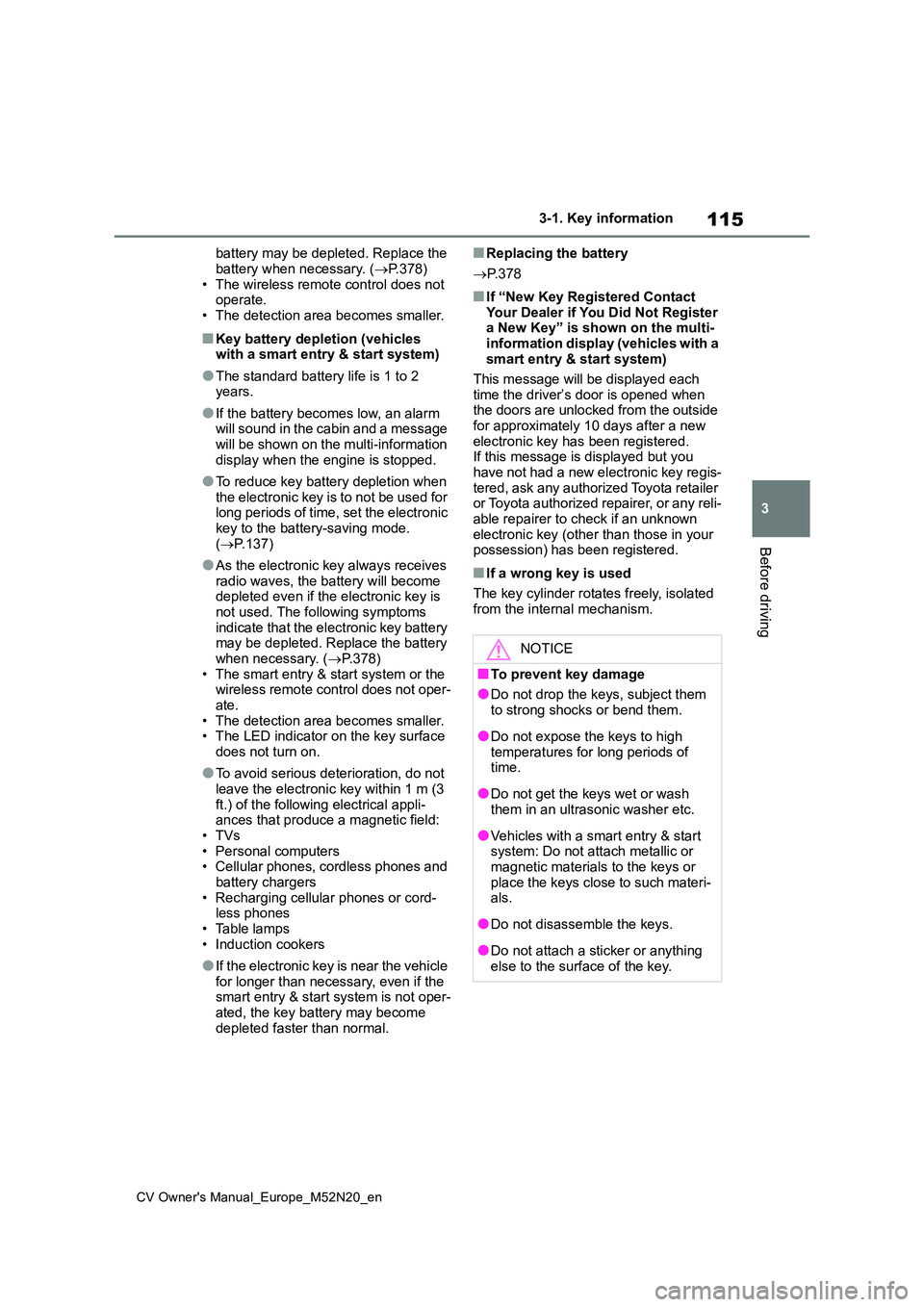
115
3
CV Owner's Manual_Europe_M52N20_en
3-1. Key information
Before driving
battery may be depleted. Replace the
battery when necessary. ( P.378) • The wireless remote control does not operate.
• The detection area becomes smaller.
■Key battery depletion (vehicles with a smart entry & start system)
●The standard battery life is 1 to 2 years.
●If the battery becomes low, an alarm will sound in the cabin and a message will be shown on the multi-information
display when the engine is stopped.
●To reduce key battery depletion when
the electronic key is to not be used for long periods of time, set the electronic key to the battery-saving mode.
( P.137)
●As the electronic key always receives
radio waves, the battery will become depleted even if the electronic key is not used. The following symptoms
indicate that the electronic key battery may be depleted. Replace the battery when necessary. ( P.378)
• The smart entry & start system or the wireless remote control does not oper-ate.
• The detection area becomes smaller. • The LED indicator on the key surface does not turn on.
●To avoid serious deterioration, do not leave the electronic key within 1 m (3
ft.) of the following electrical appli- ances that produce a magnetic field:•TVs
• Personal computers • Cellular phones, cordless phones and battery chargers
• Recharging cellular phones or cord- less phones• Table lamps
• Induction cookers
●If the electronic key is near the vehicle
for longer than necessary, even if the smart entry & start system is not oper-ated, the key battery may become
depleted faster than normal.
■Replacing the battery
P. 3 7 8
■If “New Key Registered Contact Your Dealer if You Did Not Register a New Key” is shown on the multi-
information display (vehicles with a smart entry & start system)
This message will be displayed each
time the driver’s door is opened when the doors are unlocked from the outside for approximately 10 days after a new
electronic key has been registered. If this message is displayed but you have not had a new electronic key regis-
tered, ask any authorized Toyota retailer or Toyota authorized repairer, or any reli-able repairer to check if an unknown
electronic key (other than those in your possession) has been registered.
■If a wrong key is used
The key cylinder rotates freely, isolated
from the internal mechanism.
NOTICE
■To prevent key damage
●Do not drop the keys, subject them
to strong shocks or bend them.
●Do not expose the keys to high
temperatures for long periods of time.
●Do not get the keys wet or wash them in an ultrasonic washer etc.
●Vehicles with a smart entry & start system: Do not attach metallic or magnetic materials to the keys or
place the keys close to such materi- als.
●Do not disassemble the keys.
●Do not attach a sticker or anything
else to the surface of the key.
Page 124 of 618

122
CV Owner's Manual_Europe_M52N20_en
3-2. Opening, closing and locking the doors
■Door lock switches (to
lock/unlock)
1 Locks all the doors
2 Unlocks all the doors
■Inside lock buttons
1 Locks the door
2 Unlocks the door
The front doors can be opened by pull-
ing the inside handle even if the lock
buttons are in the lock position.
■Locking the front doors from the outside without a key
1 Move the inside lock button to the
lock position.
2 Close the door while pulling the door handle.
Vehicles without a smart entry & start
system
The door cannot be locked if the key is in the engine switch.
Vehicles with a smart entry & start system
The door cannot be locked if the engine
switch is in ACC or ON, or the electronic key is left inside the vehicle.
The key may not be detected correctly
and the door may be locked.
■Open door warning buzzer
If a door or the back door is not fully closed, a buzzer will sound when the
vehicle speed reaches 5 km/h (3 mph).
The open door(s) or back door is indi- cated on the multi-information display.
WARNING
■When opening or closing a door
Check the surroundings of the vehicle
such as whether the vehicle is on an incline, whether there is enough space for a door to open and whether
a strong wind is blowing. When open- ing or closing the door, hold the door handle tightly to prepare for any
unpredictable movement.
■When using the wireless remote
control or the key and operating the power windows
Operate the power windows after
checking to make sure that there is no possibility of any passenger having any of their body parts caught in the
windows. Also, do not allow children to operate the wireless remote control or the key. It is possible for children
and other passengers to get caught in the power windows.
Unlocking and locking the
doors from the inside